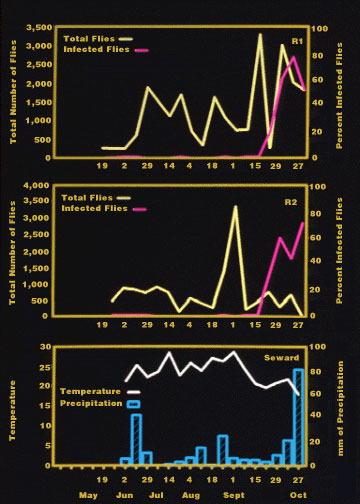Entomophthora muscae (original) (raw)
Back to Pathogens Table of Contents

Entomophthora muscae
(=Entomophthora schizophorae)
Zygomycetes: Entomophthorales
by D. W. Watson, Fort Dodge Animal Health, Princeton, NJ
Entomophthora muscae is a well known fungal disease of adult Diptera with a wide range of potential hosts. First described by Cohn in 1855 from an epizootic of house flies, E. muscae has been recognized as a potential biological agent for many years.

Appearance
Patent infection in the house fly is characterized by a distended abdomen, legs spread and wings out-stretched (see photograph above). The intersegmental membranes of the swollen abdomen give the cadaver a characteristic striped pattern. The labellum may be lowered and the cadaver may be attached to the surface by the mouthparts. A halo of primary conidia often surrounds the cadaver, and is particularly evident on glass surfaces. The release of primary conidia from the cadaver is termed a "conidial shower." Disease transmission depends on direct contact with these conidia.

Habitat
Entomophthora muscae epizootics usually occur in the spring and fall of the year, and occur in most temperate regions. Sporulation is timed to coincide with periods of cool, and humid conditions in areas with an abundance of resting hosts. Such environmental conditions promote primary conidial production and disease transmission. In the northeastern U.S., for example, _E. muscae_-killed cluster flies are frequently seen attached, indoors, to windows or window frames where other flies tend to aggregate. In agricultural settings, fly cadavers may be seen attached to the underside of plant leaves, along field margins, on fence rails and feed bunks, and in dairy barns and poultry houses.

Pests Attacked (Host Range)
Since Cohn's initial observations, epizootics have been observed in adult Diptera in the families Muscidae, Calliphoridae, Sarcophagidae, Tachinidae, Drosophilidae, Scatophagidae, Culicidae and Syrphidae.

Life Cycle
There are at least two forms of conidia produced by E. muscae. Large primary conidia are produced soon after the fly dies, but in the event no hosts are available for the primary conidia, a smaller secondary conidia may develop from the primary conidia.
Conidia are produced at the apex of a conidiophore, and when mature, are forcibly ejected onto the surrounding surface area. Conidia may fall onto un-infected resting flies close-by. The conidia germinate within a few hours and a germ tube begins to penetrate the insect's cuticle (Brobyn and Wilding, 1983). Once inside the hemocoel, the cytoplasm streams through the germ tube and into the insect's hemolymph. The fungus replicates in the fly hemolymph, and progressively consumes all the hemolymph in about 5-7 days. In the evening hours, critically ill insects tend to crawl up verticle surfaces to die at an elevated position. Approximately 3 hours after death the condiophores begin to emerge from the intersegmental membranes to initiate the conidial shower.

Seasonal abundance and Entomophthora muscae prevalence for house flies in Nebraska and climatological data. D.Watson

Relative Effectiveness
Epizootics appear to be influenced by abiotic factors, particularly temperature (Watson and Petersen 1993). When mid summer temperature were high the prevalence of disease decreased to near non existent levels, but recovered late in the season with the arrival of cooler field conditions. Entomophthora muscae was prevalent on two dairy farms in Nebraska, where 76 and 80% of the house fly population were infected (table above). In laboratory studies, E. muscae infected house flies exhibited behavioral fevers and were able to rid themselves of infection by resting at temperatures that inhibited fungal growth (Watson et al. 1993).

Conservation
Unfortunately, E. muscae is a fastidious organism and cannot be easily cultured artifically. Colonies are usually maintained through direct fly to fly transmissions. Hyphal bodies of E. muscae have been stored in liquid nitrogen (Humber, 1992). However, artificial infection through injection has met with limited results.

Pesticide Susceptibility
Insecticide residues significantly inhibited the germination of primary conidia (Mullens and Rodriguez, 1986). Permethrin and naled had the least inhibition followed by tetrachlorvinphos/dichlorvos and carbaryl, and malathion and dimethoate.

Commercial Availability
Entomophthora muscae is not commercially available.

References
Brobyn, P. J. and N. Wilding. 1983. Invasive and developmental process of Entomophthora muscae infecting house flies, Musca domestica. Trans. Br. Mycol. Soc. 80:1-8.
Humber, R. A. 1992. Collection of Entomopathogenic fungal cultures. ARS Catalog of Strains. ARS 110. PPRU/US Plant, Soil and Nutrition Laboratory, Ithaca, NY. USDA/ARS.
Mullens, B. A., and J. L. Rodriguez. 1986. Insecticide effects on Entomophthora muscae, (Zygomycetes: Entomophthorales). Entomophaga 31:65-71.
Watson, D. W., B. A. Mullens, and J. J. Petersen. 1993. Behavioral fever response of Musca domestica (Diptera: Muscidae) to infection by Entomophthora muscae (Zygomycetes: Entomophthorales). J. Invert. Patholog. 61:10-16.
Watson, D. W., and J. J. Petersen. 1993. Seasonal activity of Entomophthora muscae (Zygomycetes: Entomophthorales) in Musca domestica (Diptera: Muscidae) with reference to temperature and relative humidity. Biological Control 3: 182-190.

Back to Pathogens Table of Contents
